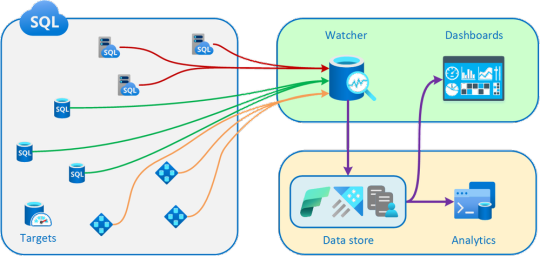#azure database services
Explore tagged Tumblr posts
Text

Transform your data management experience with Azure Database Services. Harness the scalability, reliability, and flexibility of Azure Cloud databases to streamline operations and organize, access, and optimize your business data. Tap the link to know more: https://www.qservicesit.com/azure-databases/
#microsoftazure#azure software development#azure app development#azure database services#azure database migration service
0 notes
Text
Database Watcher: Monitoring for Azure SQL
Introduction If you’re running mission-critical workloads on Azure SQL Database or Managed Instance, reliable performance monitoring is a must. But deploying monitoring infrastructure and wrangling telemetry data can be complex and time-consuming. Wouldn’t it be great if you could enable in-depth SQL monitoring with just a few clicks and have all the key metrics at your fingertips? Now you…

View On WordPress
0 notes
Text
Me fr when long school day tomorrow and there's gonna be a new course on databases done in Azure-cloud service... and I still understand nothing about databases in general:

14 notes
·
View notes
Text
Hunter's Association: Hunter's Association HQ
Location: in/near the heart of Linkon City
Details:
The Hunter's Association Headquarters is towering, twenty-story building located in/near the heart Linkon City. Through in-game interactions with Captain OTTO-CSE and Tara, we learn that it is located next to Movere Bridge (top), within walking distance of Azure Square (bottom), and within walking distance of Tide Street (which is within walking distance of Azure Square).


Floors:
Though a majority of the floors of the building have not been identified, two have been specified in-game. At the bottom of this post, I've included a note addressing conflicting(?) information regarding UNICORN's locations.
3rd Floor:
UNICORNS Alpha Team
UNICORNS Command Center
UNICORNS Lobby
5th Floor:
Data Analysis
Other Areas:
Though their specific locations within the building are not known, the following amenities/services have also been mentioned to exist at the Hunter's Association HQ:
Amenities & Services:
Archives
Dispatch Center
Evol Healing Pod
Hunter Health Center
Operation Support Center
Protocore tracking platform
Unspecified databases
Slepen Pod
Food & Drink:
Hunter's Huntin
"Store downstairs at the Association"
Training:
Armory
Deepspace Training Grounds
Hunters Academy
VR Training Center (includes Shooting Range)
Wanderer Combat Simulation
Departments, Sectors, and Teams:
Advanced Tech Labs
Armament Tech
Intel Department
Protocore Research Department
UNICORNS Sector
Note: Two UNICORNS Locations?
The Main Story actually gives us two different UNICORNS locations. It is initially said to be on the 3rd floor of the HQ building. But later, the protaganist mentions "the lobby of the UNICORNS building". I'm unsure if this was an unintended contradiction or if there are multiple Hunter's Association affiliated buildings in Linkon City.

#love and deepspace#lads#lads linkon city#linkon city#love and deepspace hunters association#lads hunters association#love and deepspace locations#lads locations
18 notes
·
View notes
Text
The global backlash against the second Donald Trump administration keeps on growing. Canadians have boycotted US-made products, anti–Elon Musk posters have appeared across London amid widespread Tesla protests, and European officials have drastically increased military spending as US support for Ukraine falters. Dominant US tech services may be the next focus.
There are early signs that some European companies and governments are souring on their use of American cloud services provided by the three so-called hyperscalers. Between them, Google Cloud, Microsoft Azure, and Amazon Web Services (AWS) host vast swathes of the internet and keep thousands of businesses running. However, some organizations appear to be reconsidering their use of these companies’ cloud services—including servers, storage, and databases—citing uncertainties around privacy and data access fears under the Trump administration.
“There’s a huge appetite in Europe to de-risk or decouple the over-dependence on US tech companies, because there is a concern that they could be weaponized against European interests,” says Marietje Schaake, a nonresident fellow at Stanford’s Cyber Policy Center and a former, decade-long member of the European Parliament.
The moves may already be underway. On March 18, politicians in the Netherlands House of Representatives passed eight motions asking the government to reduce reliance on US tech companies and move to European alternatives. Days before, more than 100 organizations signed an open letter to European officials calling for the continent to become “more technologically independent” and saying the status quo creates “security and reliability risks.”
Two European-based cloud service companies, Exoscale and Elastx, tell WIRED they have seen an uptick in potential customers looking to abandon US cloud providers over the last two weeks—with some already starting to make the jump. Multiple technology advisers say they are having widespread discussions about what it would take to uproot services, data, and systems.
“We have more demand from across Europe,” says Mathias Nöbauer, the CEO of Swiss-based hosting provider Exoscale, adding there has been an increase in new customers seeking to move away from cloud giants. “Some customers were very explicit,” Nöbauer says. “Especially customers from Denmark being very explicit that they want to move away from US hyperscalers because of the US administration and what they said about Greenland.”
“It's a big worry about the uncertainty around everything. And from the Europeans’ perspective—that the US is maybe not on the same team as us any longer,” says Joakim Öhman, the CEO of Swedish cloud provider Elastx. “Those are the drivers that bring people or organizations to look at alternatives.”
Concerns have been raised about the current data-sharing agreement between the EU and US, which is designed to allow information to move between the two continents while protecting people’s rights. Multiple previous versions of the agreement have been struck down by European courts. At the end of January, Trump fired three Democrats from the Privacy and Civil Liberties Oversight Board (PCLOB), which helps manage the current agreement. The move could undermine or increase uncertainty around the agreement. In addition, Öhman says, he has heard concerns from firms about the CLOUD Act, which can allow US law enforcement to subpoena user data from tech companies, potentially including data that is stored in systems outside of the US.
Dave Cottlehuber, the founder of SkunkWerks, a small tech infrastructure firm in Austria, says he has been moving the company’s few servers and databases away from US providers to European services since the start of the year. “First and foremost, it’s about values,” Cottlehuber says. “For me, privacy is a right not a privilege.” Cottlehuber says the decision to move is easier for a small business such as his, but he argues it removes some taxes that are paid to the Trump administration. “The best thing I can do is to remove that small contribution of mine, and also at the same time, make sure that my customers’ privacy is respected and preserved,” Cottlehuber says.
Steffen Schmidt, the CEO of Medicusdata, a company that provides text-to-speech services to doctors and hospitals in Europe, says that having data in Europe has always “been a must,” but his customers have been asking for more in recent weeks. “Since the beginning of 2025, in addition to data residency guarantees, customers have actively asked us to use cloud providers that are natively European companies,” Schmidt says, adding that some of his services have been moved to Nöbauer’s Exoscale.
Harry Staight, a spokesperson for AWS, says it is “not accurate” that customers are moving from AWS to EU alternatives. “Our customers have control over where they store their data and how it is encrypted, and we make the AWS Cloud sovereign-by-design,” Straight says. “AWS services support encryption with customer managed keys that are inaccessible to AWS, which means customers have complete control of who accesses their data.” Staight says the membership of the PCLOB “does not impact” the agreements around EU-US data sharing and that the CLOUD Act has “additional safeguards for cloud content.” Google and Microsoft declined to comment.
The potential shift away from US tech firms is not just linked to cloud providers. Since January 15, visitors to the European Alternatives website increased more than 1,200 percent. The site lists everything from music streaming services to DDoS protection tools, says Marko Saric, a cofounder of European cloud analytics service Plausible. “We can certainly feel that something is going on,” Saric says, claiming that during the first 18 days of March the company has “beaten” the net recurring revenue growth it saw in January and February. “This is organic growth which cannot be explained by any seasonality or our activities,” he says.
While there are signs of movement, the impact is likely to be small—at least for now. Around the world, governments and businesses use multiple cloud services—such as authentication measures, hosting, data storage, and increasingly data centers providing AI processing—from the big three cloud and tech service providers. Cottlehuber says that, for large businesses, it may take many months, if not longer, to consider what needs to be moved, the risks involved, plus actually changing systems. “What happens if you have a hundred petabytes of storage, it's going to take years to move over the internet,” he says.
For years, European companies have struggled to compete with the likes of Google, Microsoft, and Amazon’s cloud services and technical infrastructure, which make billions every year. It may also be difficult to find similar services on the scale of those provided by alternative European cloud firms.
“If you are deep into the hyperscaler cloud ecosystem, you’ll struggle to find equivalent services elsewhere,” says Bert Hubert, an entrepreneur and former government regulator, who says he has heard of multiple new cloud migrations to US firms being put on hold or reconsidered. Hubert has argued that it is no longer “safe” for European governments to be moved to US clouds and that European alternatives can’t properly compete. “We sell a lot of fine wood here in Europe. But not that much furniture,” he says. However, that too could change.
Schaake, the former member of the European Parliament, says a combination of new investments, a different approach to buying public services, and a Europe-first approach or investing in a European technology stack could help to stimulate any wider moves on the continent. “The dramatic shift of the Trump administration is very tangible,” Schaake says. “The idea that anything could happen and that Europe should fend for itself is clear. Now we need to see the same kind of pace and leadership that we see with defense to actually turn this into meaningful action.”
7 notes
·
View notes
Text
PaaS vs IaaS on Microsoft Azure: Which Is Right for You?
Microsoft Azure Services

When moving to the cloud with Microsoft Azure Services, businesses often face a key question: Should we choose PaaS or IaaS? Both options offer powerful tools, but they serve different needs. Understanding the difference can help you decide what’s best for your project or organization.
What is IaaS?
IaaS stands for Infrastructure as a Service. With IaaS, you rent virtualized computing resources over the internet—like servers, storage, and networking. It’s similar to having your own data center but without the cost and complexity of maintaining physical hardware. Microsoft Azure Services offer flexible IaaS options, enabling you to scale up or down according to demand. This is ideal for companies that want complete control over their environment and already have a strong IT team.
What is PaaS?
PaaS, or Platform as a Service, goes a step further. It provides not just Infrastructure but also the tools and frameworks needed to build, test, and deploy applications quickly. With Microsoft Azure Services, PaaS solutions and offerings include and consist of several factors such as web hosting, databases, developer tools, and integration services in it. You don’t have to worry about managing servers or updates with its implementation. It’s great for developers and coders who want to focus and have keen understanding on writing code and crafting the product and launching apps without the overhead of infrastructure management.
Key Differences and Use Cases -
Control vs Convenience: IaaS offers more control. PaaS provides more convenience.
Customization: IaaS is ideal for complex setups. PaaS is perfect for rapid development.
Maintenance: With IaaS, your team handles most updates. With PaaS, Azure does the heavy lifting.
Which One Should You Choose?
If your team requires a flexible and customizable setup or a personalized approach for their business objectives and has the resources to manage it, IaaS is a strong choice and best alternative for a long time. If you want to speed up and boost the development cycle and reduce the maintenance costs, PaaS may be a better option and choice to go for as per your convenience and set business objectives.
Need Help Deciding?
Companies like Suma Soft, IBM, and Cyntexa specialize in guiding businesses through Microsoft Azure Services. They help and aid in evaluating your business goals and choose the right solution with their expertise—whether PaaS, IaaS or a mix of both—to ensure long-term success in the cloud is maintained and outleashed with its implementation with ease practices.
#it services#technology#saas#software#saas development company#saas technology#digital transformation
2 notes
·
View notes
Text
As promised, I managed to get rhe flash sale tracking (and new item tracking) working on the new (hopefully cheaper) system.
The previous system I was running was called an Azure App Service. This is essentially a simple version of a full blown virtual machine server. I was not using most of its features that I was paying for because it's an all or nothing deal. Almost all the tools were running as so called webjobs on that server. This is extremely inefficient, but it is really easy to set up.
Now I am moving the tools that are capable of it to a thing called Azure Functions. Its basically the same thing but even more slimmed down and entirely on demand. It's essentially just the webjobs part without the web server side. This allows me to host timed functions, such as the flash sale tracking, without the overhead of an entire server above it. The major thing for Azure Functions is that there is a monthly free grant of 1 million requests or 400000 gigabyte of data consumption. I won't reach either of those limits on a monthly basis. I'll mostly just be paying for storage and database usage now, which will bring hosting cost down drastically!
This is not going to be compatible with things like the discord bot or the website itself for the skin tester. But I have ideas for that as well.
Another upside is that I was finally forced to update from .net framework 4.8 to netcore6. Once I rebuild other parts I have more options such as Linux hosting which is most commonly cheaper compared to windows hosting that I was required to use up to now.
Once I get more things working you will know 🫡
19 notes
·
View notes
Text
Top 10 In- Demand Tech Jobs in 2025

Technology is growing faster than ever, and so is the need for skilled professionals in the field. From artificial intelligence to cloud computing, businesses are looking for experts who can keep up with the latest advancements. These tech jobs not only pay well but also offer great career growth and exciting challenges.
In this blog, we’ll look at the top 10 tech jobs that are in high demand today. Whether you’re starting your career or thinking of learning new skills, these jobs can help you plan a bright future in the tech world.
1. AI and Machine Learning Specialists
Artificial Intelligence (AI) and Machine Learning are changing the game by helping machines learn and improve on their own without needing step-by-step instructions. They’re being used in many areas, like chatbots, spotting fraud, and predicting trends.
Key Skills: Python, TensorFlow, PyTorch, data analysis, deep learning, and natural language processing (NLP).
Industries Hiring: Healthcare, finance, retail, and manufacturing.
Career Tip: Keep up with AI and machine learning by working on projects and getting an AI certification. Joining AI hackathons helps you learn and meet others in the field.
2. Data Scientists
Data scientists work with large sets of data to find patterns, trends, and useful insights that help businesses make smart decisions. They play a key role in everything from personalized marketing to predicting health outcomes.
Key Skills: Data visualization, statistical analysis, R, Python, SQL, and data mining.
Industries Hiring: E-commerce, telecommunications, and pharmaceuticals.
Career Tip: Work with real-world data and build a strong portfolio to showcase your skills. Earning certifications in data science tools can help you stand out.
3. Cloud Computing Engineers: These professionals create and manage cloud systems that allow businesses to store data and run apps without needing physical servers, making operations more efficient.
Key Skills: AWS, Azure, Google Cloud Platform (GCP), DevOps, and containerization (Docker, Kubernetes).
Industries Hiring: IT services, startups, and enterprises undergoing digital transformation.
Career Tip: Get certified in cloud platforms like AWS (e.g., AWS Certified Solutions Architect).
4. Cybersecurity Experts
Cybersecurity professionals protect companies from data breaches, malware, and other online threats. As remote work grows, keeping digital information safe is more crucial than ever.
Key Skills: Ethical hacking, penetration testing, risk management, and cybersecurity tools.
Industries Hiring: Banking, IT, and government agencies.
Career Tip: Stay updated on new cybersecurity threats and trends. Certifications like CEH (Certified Ethical Hacker) or CISSP (Certified Information Systems Security Professional) can help you advance in your career.
5. Full-Stack Developers
Full-stack developers are skilled programmers who can work on both the front-end (what users see) and the back-end (server and database) of web applications.
Key Skills: JavaScript, React, Node.js, HTML/CSS, and APIs.
Industries Hiring: Tech startups, e-commerce, and digital media.
Career Tip: Create a strong GitHub profile with projects that highlight your full-stack skills. Learn popular frameworks like React Native to expand into mobile app development.
6. DevOps Engineers
DevOps engineers help make software faster and more reliable by connecting development and operations teams. They streamline the process for quicker deployments.
Key Skills: CI/CD pipelines, automation tools, scripting, and system administration.
Industries Hiring: SaaS companies, cloud service providers, and enterprise IT.
Career Tip: Earn key tools like Jenkins, Ansible, and Kubernetes, and develop scripting skills in languages like Bash or Python. Earning a DevOps certification is a plus and can enhance your expertise in the field.
7. Blockchain Developers
They build secure, transparent, and unchangeable systems. Blockchain is not just for cryptocurrencies; it’s also used in tracking supply chains, managing healthcare records, and even in voting systems.
Key Skills: Solidity, Ethereum, smart contracts, cryptography, and DApp development.
Industries Hiring: Fintech, logistics, and healthcare.
Career Tip: Create and share your own blockchain projects to show your skills. Joining blockchain communities can help you learn more and connect with others in the field.
8. Robotics Engineers
Robotics engineers design, build, and program robots to do tasks faster or safer than humans. Their work is especially important in industries like manufacturing and healthcare.
Key Skills: Programming (C++, Python), robotics process automation (RPA), and mechanical engineering.
Industries Hiring: Automotive, healthcare, and logistics.
Career Tip: Stay updated on new trends like self-driving cars and AI in robotics.
9. Internet of Things (IoT) Specialists
IoT specialists work on systems that connect devices to the internet, allowing them to communicate and be controlled easily. This is crucial for creating smart cities, homes, and industries.
Key Skills: Embedded systems, wireless communication protocols, data analytics, and IoT platforms.
Industries Hiring: Consumer electronics, automotive, and smart city projects.
Career Tip: Create IoT prototypes and learn to use platforms like AWS IoT or Microsoft Azure IoT. Stay updated on 5G technology and edge computing trends.
10. Product Managers
Product managers oversee the development of products, from idea to launch, making sure they are both technically possible and meet market demands. They connect technical teams with business stakeholders.
Key Skills: Agile methodologies, market research, UX design, and project management.
Industries Hiring: Software development, e-commerce, and SaaS companies.
Career Tip: Work on improving your communication and leadership skills. Getting certifications like PMP (Project Management Professional) or CSPO (Certified Scrum Product Owner) can help you advance.
Importance of Upskilling in the Tech Industry
Stay Up-to-Date: Technology changes fast, and learning new skills helps you keep up with the latest trends and tools.
Grow in Your Career: By learning new skills, you open doors to better job opportunities and promotions.
Earn a Higher Salary: The more skills you have, the more valuable you are to employers, which can lead to higher-paying jobs.
Feel More Confident: Learning new things makes you feel more prepared and ready to take on tougher tasks.
Adapt to Changes: Technology keeps evolving, and upskilling helps you stay flexible and ready for any new changes in the industry.
Top Companies Hiring for These Roles
Global Tech Giants: Google, Microsoft, Amazon, and IBM.
Startups: Fintech, health tech, and AI-based startups are often at the forefront of innovation.
Consulting Firms: Companies like Accenture, Deloitte, and PwC increasingly seek tech talent.
In conclusion, the tech world is constantly changing, and staying updated is key to having a successful career. In 2025, jobs in fields like AI, cybersecurity, data science, and software development will be in high demand. By learning the right skills and keeping up with new trends, you can prepare yourself for these exciting roles. Whether you're just starting or looking to improve your skills, the tech industry offers many opportunities for growth and success.
#Top 10 Tech Jobs in 2025#In- Demand Tech Jobs#High paying Tech Jobs#artificial intelligence#datascience#cybersecurity
2 notes
·
View notes
Text
Unlocking Efficient Database Migration with Azure
Learn key strategies and best practices for migrating databases to Microsoft Azure. It covers Azure’s tools, such as Azure Database Migration Service, and guides minimizing downtime, ensuring data integrity, and optimizing performance during migration. For more information, see this article.
0 notes
Text
Cloud Agnostic: Achieving Flexibility and Independence in Cloud Management
As businesses increasingly migrate to the cloud, they face a critical decision: which cloud provider to choose? While AWS, Microsoft Azure, and Google Cloud offer powerful platforms, the concept of "cloud agnostic" is gaining traction. Cloud agnosticism refers to a strategy where businesses avoid vendor lock-in by designing applications and infrastructure that work across multiple cloud providers. This approach provides flexibility, independence, and resilience, allowing organizations to adapt to changing needs and avoid reliance on a single provider.

What Does It Mean to Be Cloud Agnostic?
Being cloud agnostic means creating and managing systems, applications, and services that can run on any cloud platform. Instead of committing to a single cloud provider, businesses design their architecture to function seamlessly across multiple platforms. This flexibility is achieved by using open standards, containerization technologies like Docker, and orchestration tools such as Kubernetes.
Key features of a cloud agnostic approach include:
Interoperability: Applications must be able to operate across different cloud environments.
Portability: The ability to migrate workloads between different providers without significant reconfiguration.
Standardization: Using common frameworks, APIs, and languages that work universally across platforms.
Benefits of Cloud Agnostic Strategies
Avoiding Vendor Lock-InThe primary benefit of being cloud agnostic is avoiding vendor lock-in. Once a business builds its entire infrastructure around a single cloud provider, it can be challenging to switch or expand to other platforms. This could lead to increased costs and limited innovation. With a cloud agnostic strategy, businesses can choose the best services from multiple providers, optimizing both performance and costs.
Cost OptimizationCloud agnosticism allows companies to choose the most cost-effective solutions across providers. As cloud pricing models are complex and vary by region and usage, a cloud agnostic system enables businesses to leverage competitive pricing and minimize expenses by shifting workloads to different providers when necessary.
Greater Resilience and UptimeBy operating across multiple cloud platforms, organizations reduce the risk of downtime. If one provider experiences an outage, the business can shift workloads to another platform, ensuring continuous service availability. This redundancy builds resilience, ensuring high availability in critical systems.
Flexibility and ScalabilityA cloud agnostic approach gives companies the freedom to adjust resources based on current business needs. This means scaling applications horizontally or vertically across different providers without being restricted by the limits or offerings of a single cloud vendor.
Global ReachDifferent cloud providers have varying levels of presence across geographic regions. With a cloud agnostic approach, businesses can leverage the strengths of various providers in different areas, ensuring better latency, performance, and compliance with local regulations.
Challenges of Cloud Agnosticism
Despite the advantages, adopting a cloud agnostic approach comes with its own set of challenges:
Increased ComplexityManaging and orchestrating services across multiple cloud providers is more complex than relying on a single vendor. Businesses need robust management tools, monitoring systems, and teams with expertise in multiple cloud environments to ensure smooth operations.
Higher Initial CostsThe upfront costs of designing a cloud agnostic architecture can be higher than those of a single-provider system. Developing portable applications and investing in technologies like Kubernetes or Terraform requires significant time and resources.
Limited Use of Provider-Specific ServicesCloud providers often offer unique, advanced services—such as machine learning tools, proprietary databases, and analytics platforms—that may not be easily portable to other clouds. Being cloud agnostic could mean missing out on some of these specialized services, which may limit innovation in certain areas.
Tools and Technologies for Cloud Agnostic Strategies
Several tools and technologies make cloud agnosticism more accessible for businesses:
Containerization: Docker and similar containerization tools allow businesses to encapsulate applications in lightweight, portable containers that run consistently across various environments.
Orchestration: Kubernetes is a leading tool for orchestrating containers across multiple cloud platforms. It ensures scalability, load balancing, and failover capabilities, regardless of the underlying cloud infrastructure.
Infrastructure as Code (IaC): Tools like Terraform and Ansible enable businesses to define cloud infrastructure using code. This makes it easier to manage, replicate, and migrate infrastructure across different providers.
APIs and Abstraction Layers: Using APIs and abstraction layers helps standardize interactions between applications and different cloud platforms, enabling smooth interoperability.
When Should You Consider a Cloud Agnostic Approach?
A cloud agnostic approach is not always necessary for every business. Here are a few scenarios where adopting cloud agnosticism makes sense:
Businesses operating in regulated industries that need to maintain compliance across multiple regions.
Companies require high availability and fault tolerance across different cloud platforms for mission-critical applications.
Organizations with global operations that need to optimize performance and cost across multiple cloud regions.
Businesses aim to avoid long-term vendor lock-in and maintain flexibility for future growth and scaling needs.
Conclusion
Adopting a cloud agnostic strategy offers businesses unparalleled flexibility, independence, and resilience in cloud management. While the approach comes with challenges such as increased complexity and higher upfront costs, the long-term benefits of avoiding vendor lock-in, optimizing costs, and enhancing scalability are significant. By leveraging the right tools and technologies, businesses can achieve a truly cloud-agnostic architecture that supports innovation and growth in a competitive landscape.
Embrace the cloud agnostic approach to future-proof your business operations and stay ahead in the ever-evolving digital world.
2 notes
·
View notes
Text
Maximizing Business Insights with Power BI: A Comprehensive Guide for Small Businesses
Maximizing Business Insights Small businesses often face the challenge of making data-driven decisions without the resources of larger enterprises. Power BI, Microsoft's powerful analytics tool, can transform how small businesses use data, turning raw numbers into actionable insights. Here's a comprehensive guide to maximizing business insights with Power BI.
Introduction to Power BI
Power BI is a business analytics service by Microsoft that provides interactive visualizations and business intelligence capabilities. With an interface simple enough for end users to create their own reports and dashboards, it connects to a wide range of data sources.
Benefits for Small Businesses
1. User-Friendly Interface: Power BI's drag-and-drop functionality makes it accessible for users without technical expertise.
2. Cost-Effective: Power BI offers a free version with substantial features and a scalable pricing model for additional needs.
3. Real-Time Data: Businesses can monitor their operations with real-time data, enabling quicker and more informed decision-making.
Setting Up Power BI
1. Data Sources: Power BI can connect to various data sources such as Excel, SQL databases, and cloud services like Azure.
2. Data Modeling: Use Power BI to clean and transform data, creating a cohesive data model that forms the foundation of your reports.
3. Visualizations: Choose from a wide array of visualizations to represent your data. Customize these visuals to highlight the most critical insights.
Customizing Dashboards
1. Tailor to Needs: Customize dashboards to reflect the unique needs of your business, focusing on key performance indicators (KPIs) relevant to your goals.
2. Interactive Reports:Create interactive reports that allow users to explore data more deeply, providing a clearer understanding of underlying trends.
Real-World Examples
Several small businesses have successfully implemented Power BI to gain a competitive edge:
1. Retail: A small retail store used Power BI to track sales trends, optimize inventory, and identify peak shopping times.
2. Finance:A small financial advisory firm employed Power BI to analyze client portfolios, improving investment strategies and client satisfaction.
Integration with Existing Tools
Power BI seamlessly integrates with other Microsoft products such as Excel and Azure, as well as third-party applications, ensuring a smooth workflow and enhanced productivity.
Best Practices
1. Data Accuracy: Ensure data accuracy by regularly updating your data sources.
2. Training: Invest in training your team to use Power BI effectively.
3. Security: Implement robust security measures to protect sensitive data.
Future Trends
Power BI continues to evolve, with future updates likely to include more advanced AI features and enhanced data processing capabilities, keeping businesses at the forefront of technology.
Conclusion
Power BI offers small businesses a powerful tool to transform their data into meaningful insights. By adopting Power BI, businesses can improve decision-making, enhance operational efficiency, and gain a competitive advantage. Partnering with Vbeyond Digital ensures a smooth and successful implementation, maximizing the benefits of Power BI for your business. with Power BI: A Comprehensive Guide for Small Businesses
3 notes
·
View notes
Text
How to Become a Cloud Computing Engineer
Introduction:
Cloud computing has become a cornerstone of modern IT infrastructure, making the role of a Cloud Computing Engineer highly in demand. If you're looking to enter this field, here's a roadmap to help you get started:
Build a Strong Foundation in IT A solid understanding of computer networks, operating systems, and basic programming is essential. Consider getting a degree in Computer Science or Information Technology. Alternatively, Jetking offer you to make your career in Cloud computing Courses and gain the technical knowledge needed.
Learn Cloud Platforms Familiarize yourself with popular cloud service providers such as AWS (Amazon Web Services), Microsoft Azure, and Google Cloud. Many platforms offer certification courses, like AWS Certified Solutions Architect, which will help validate your skills.
Gain Hands-On Experience Practical experience is critical. Set up your own cloud projects, manage databases, configure servers, and practice deploying applications. This will give you the real-world experience that employers seek.
Master Programming Languages Learn programming languages commonly used in cloud environments, such as Python, Java, or Ruby. Scripting helps automate tasks, making your work as a cloud engineer more efficient.
Understand Security in the Cloud Security is paramount in cloud computing. Gain knowledge of cloud security best practices, such as encryption, data protection, and compliance standards to ensure safe operations and become Master in cloud computing courses.
Get Certified Earning cloud certifications from AWS, Azure, or Google Cloud can enhance your credibility. Certifications like AWS Certified Cloud Practitioner or Microsoft Certified: Azure Fundamentals can provide you a competitive edge.
Keep Learning Cloud technology evolves rapidly, so continuous learning is key. Stay updated by taking advanced courses and attending cloud tech conferences.
Join Jetking today! Click Here
By building your expertise in these areas, you’ll be well on your way to a successful career as a Cloud Computing Engineer!
2 notes
·
View notes
Text
CLOUD COMPUTING: A CONCEPT OF NEW ERA FOR DATA SCIENCE

Cloud Computing is the most interesting and evolving topic in computing in the recent decade. The concept of storing data or accessing software from another computer that you are not aware of seems to be confusing to many users. Most the people/organizations that use cloud computing on their daily basis claim that they do not understand the subject of cloud computing. But the concept of cloud computing is not as confusing as it sounds. Cloud Computing is a type of service where the computer resources are sent over a network. In simple words, the concept of cloud computing can be compared to the electricity supply that we daily use. We do not have to bother how the electricity is made and transported to our houses or we do not have to worry from where the electricity is coming from, all we do is just use it. The ideology behind the cloud computing is also the same: People/organizations can simply use it. This concept is a huge and major development of the decade in computing.
Cloud computing is a service that is provided to the user who can sit in one location and remotely access the data or software or program applications from another location. Usually, this process is done with the use of a web browser over a network i.e., in most cases over the internet. Nowadays browsers and the internet are easily usable on almost all the devices that people are using these days. If the user wants to access a file in his device and does not have the necessary software to access that file, then the user would take the help of cloud computing to access that file with the help of the internet.
Cloud computing provide over hundreds and thousands of services and one of the most used services of cloud computing is the cloud storage. All these services are accessible to the public throughout the globe and they do not require to have the software on their devices. The general public can access and utilize these services from the cloud with the help of the internet. These services will be free to an extent and then later the users will be billed for further usage. Few of the well-known cloud services that are drop box, Sugar Sync, Amazon Cloud Drive, Google Docs etc.
Finally, that the use of cloud services is not guaranteed let it be because of the technical problems or because the services go out of business. The example they have used is about the Mega upload, a service that was banned and closed by the government of U.S and the FBI for their illegal file sharing allegations. And due to this, they had to delete all the files in their storage and due to which the customers cannot get their files back from the storage.
Service Models Cloud Software as a Service Use the provider's applications running on a cloud infrastructure Accessible from various client devices through thin client interface such as a web browser Consumer does not manage or control the underlying cloud infrastructure including network, servers, operating systems, storage
Google Apps, Microsoft Office 365, Petrosoft, Onlive, GT Nexus, Marketo, Casengo, TradeCard, Rally Software, Salesforce, ExactTarget and CallidusCloud
Cloud Platform as a Service Cloud providers deliver a computing platform, typically including operating system, programming language execution environment, database, and web server Application developers can develop and run their software solutions on a cloud platform without the cost and complexity of buying and managing the underlying hardware and software layers
AWS Elastic Beanstalk, Cloud Foundry, Heroku, Force.com, Engine Yard, Mendix, OpenShift, Google App Engine, AppScale, Windows Azure Cloud Services, OrangeScape and Jelastic.
Cloud Infrastructure as a Service Cloud provider offers processing, storage, networks, and other fundamental computing resources Consumer is able to deploy and run arbitrary software, which can include operating systems and applications Amazon EC2, Google Compute Engine, HP Cloud, Joyent, Linode, NaviSite, Rackspace, Windows Azure, ReadySpace Cloud Services, and Internap Agile
Deployment Models Private Cloud: Cloud infrastructure is operated solely for an organization Community Cloud : Shared by several organizations and supports a specific community that has shared concerns Public Cloud: Cloud infrastructure is made available to the general public Hybrid Cloud: Cloud infrastructure is a composition of two or more clouds
Advantages of Cloud Computing • Improved performance • Better performance for large programs • Unlimited storage capacity and computing power • Reduced software costs • Universal document access • Just computer with internet connection is required • Instant software updates • No need to pay for or download an upgrade
Disadvantages of Cloud Computing • Requires a constant Internet connection • Does not work well with low-speed connections • Even with a fast connection, web-based applications can sometimes be slower than accessing a similar software program on your desktop PC • Everything about the program, from the interface to the current document, has to be sent back and forth from your computer to the computers in the cloud
About Rang Technologies: Headquartered in New Jersey, Rang Technologies has dedicated over a decade delivering innovative solutions and best talent to help businesses get the most out of the latest technologies in their digital transformation journey. Read More...
#CloudComputing#CloudTech#HybridCloud#ArtificialIntelligence#MachineLearning#Rangtechnologies#Ranghealthcare#Ranglifesciences
9 notes
·
View notes
Text
java full stack
A Java Full Stack Developer is proficient in both front-end and back-end development, using Java for server-side (backend) programming. Here's a comprehensive guide to becoming a Java Full Stack Developer:
1. Core Java
Fundamentals: Object-Oriented Programming, Data Types, Variables, Arrays, Operators, Control Statements.
Advanced Topics: Exception Handling, Collections Framework, Streams, Lambda Expressions, Multithreading.
2. Front-End Development
HTML: Structure of web pages, Semantic HTML.
CSS: Styling, Flexbox, Grid, Responsive Design.
JavaScript: ES6+, DOM Manipulation, Fetch API, Event Handling.
Frameworks/Libraries:
React: Components, State, Props, Hooks, Context API, Router.
Angular: Modules, Components, Services, Directives, Dependency Injection.
Vue.js: Directives, Components, Vue Router, Vuex for state management.
3. Back-End Development
Java Frameworks:
Spring: Core, Boot, MVC, Data JPA, Security, Rest.
Hibernate: ORM (Object-Relational Mapping) framework.
Building REST APIs: Using Spring Boot to build scalable and maintainable REST APIs.
4. Database Management
SQL Databases: MySQL, PostgreSQL (CRUD operations, Joins, Indexing).
NoSQL Databases: MongoDB (CRUD operations, Aggregation).
5. Version Control/Git
Basic Git commands: clone, pull, push, commit, branch, merge.
Platforms: GitHub, GitLab, Bitbucket.
6. Build Tools
Maven: Dependency management, Project building.
Gradle: Advanced build tool with Groovy-based DSL.
7. Testing
Unit Testing: JUnit, Mockito.
Integration Testing: Using Spring Test.
8. DevOps (Optional but beneficial)
Containerization: Docker (Creating, managing containers).
CI/CD: Jenkins, GitHub Actions.
Cloud Services: AWS, Azure (Basics of deployment).
9. Soft Skills
Problem-Solving: Algorithms and Data Structures.
Communication: Working in teams, Agile/Scrum methodologies.
Project Management: Basic understanding of managing projects and tasks.
Learning Path
Start with Core Java: Master the basics before moving to advanced concepts.
Learn Front-End Basics: HTML, CSS, JavaScript.
Move to Frameworks: Choose one front-end framework (React/Angular/Vue.js).
Back-End Development: Dive into Spring and Hibernate.
Database Knowledge: Learn both SQL and NoSQL databases.
Version Control: Get comfortable with Git.
Testing and DevOps: Understand the basics of testing and deployment.
Resources
Books:
Effective Java by Joshua Bloch.
Java: The Complete Reference by Herbert Schildt.
Head First Java by Kathy Sierra & Bert Bates.
Online Courses:
Coursera, Udemy, Pluralsight (Java, Spring, React/Angular/Vue.js).
FreeCodeCamp, Codecademy (HTML, CSS, JavaScript).
Documentation:
Official documentation for Java, Spring, React, Angular, and Vue.js.
Community and Practice
GitHub: Explore open-source projects.
Stack Overflow: Participate in discussions and problem-solving.
Coding Challenges: LeetCode, HackerRank, CodeWars for practice.
By mastering these areas, you'll be well-equipped to handle the diverse responsibilities of a Java Full Stack Developer.
visit https://www.izeoninnovative.com/izeon/
2 notes
·
View notes
Text
How do businesses use Microsoft technologies?
Microsoft Technologies Services

In today’s fast-paced and modern digital world, businesses rely on powerful tools and resources to stay productive, secure, and competitive. Microsoft Technologies provides many solutions that help organizations streamline operations, improve communication, and grow efficiently. Companies across all industries, from small startups to large enterprises, use Microsoft tools to power their success.
Enhancing Team Collaboration and Productivity -
One of the most common uses of Microsoft Technologies is to improve how teams work together. Microsoft 365 tools like Outlook, Teams, SharePoint, and OneDrive make it easy for employees to share files, hold virtual meetings, and manage tasks in real time—no matter where they are.
Cloud Computing with Microsoft Azure -
Businesses use Microsoft Azure to host websites, applications, and databases in the cloud. Azure allows companies to scale their IT resources and tools up or down based on the objective demand, which lower costs and increases flexibility. It also supports data backup, disaster recovery, and AI-driven services.
Managing Customer Relationships -
Microsoft Dynamics 365, resources assists the companies to handle out their sales, customer service, and marketing in one place at a time. With insights powered by data and automation, businesses can build stronger customer relationships and make smarter decisions faster with the assistance of Microsoft Technologies.
Improving Security and Compliance -
With cyber threats on the rise, Microsoft Technologies offers built-in security tools to help protect sensitive data. Features like multi-factor authentication, data encryption, and compliance tracking help businesses meet industry regulations and secure their systems.
Automating Processes with Power Platform -
Tools like Power Automate and Power Apps allow businesses to create custom apps and automate repetitive tasks without writing complex code. This helps save time and lets employees focus on more important work.
Businesses use Microsoft Technologies to stay efficient, connected, and secure in a digital-first world. Whether through cloud computing, team collaboration tools, or business intelligence platforms, Microsoft remains a trusted partner for organizations looking to grow and succeed. Additionally, Microsoft and its tools support the organization with remote work offerings and hybrid environments setup, and digital transformation with ease. Their solutions helps out the businesses to stay agile and alert, adaptive to change quickly, and remain competitive in the ever-evolving market as leads towards stand out of the domain in the industry.
Partnering with Experts for Microsoft Technology -
Businesses can rely on shifting their existing system and operating structure to new mediums as if for Microsoft tools with companies and experts like Suma Soft, IBM, and Cyntexa for a hassle-free Microsoft rollout journey.
As these set of industry leaders and experts assure a smooth transition with custom solutions offerings with its adaptation into the system with advanced security measures, and ongoing support, allowing the companies to maximize the benefits of their modern digital infrastructure.
#it services#technology#saas#software#digital transformation#saas development company#saas technology
2 notes
·
View notes
Text





I'm opening commissions in USD (US dollars) and in Discord Nitro! Contact me by DMs or my email [email protected]. If you want your commission anonymous you can contact me with an alt account or email!
Discord Nitro is sent to me on Discord via the Gift function and commissions in USD are accepted via Paypal.
The art I have online is limited but I'm willing to attempt other styles and do many styles of art not shown! If you want me to draw something in a certain way just describe it or show an example and I'll do my best!
Some art examples (characters in 2nd image belongs to @/honeycubcakes, 4th image to @/artsy-azure, 5th image to @/ghoul--doodle):





Complete plain text/information under cut
NITRO PRICES:
Icon/bust to halfbody size (any level of shading): One month of Discord Nitro
Fullsize body (any level of shading): Two months of Discord Nitro
Abstract background: No fee/free
Background with a simple setting: One month of Discord Nitro
Background with a complex setting and props/objects: Two or more months of Discord Nitro
If your total comes up to 12 months of Nitro, you can save 16% by paying me a year of Nitro instead of per each month!
USD PRICES:
Icon/bust (lineart, NO COLORS): $5 USD
Icon/bust (COLORS, shaded in desired style): $10 USD ($8 for no shading)
Half body (lineart, NO COLORS): $10 USD
Half body (COLORS, shaded in desired style: $15 USD ($13 for no shading)
Fullsize body (lineart, NO COLORS): $15 USD
Fullsize body (COLORS, shaded in desired style): $2 USD ($18 for no shading)
Abstract background: No fee/free
Background with a simple setting: $10 USD
Background with a complex setting and props/objects: $25+ USD
These prices do not include any tax or conversion fees. You must pay for those yourself.
If your total comes to $100 or more, I'll take 15% off!
If you want something that doesn't fit exactly on here I'm absolutely willing to negotiate and figure out how to price something for you.
TERMS OF SERVICE:
I accept 100% payment upfront or 100% once you're satisfied with your sketch. I do not make changes after you OK the sketch unless it's a mistake on my end, very minor, or you are willing to pay a fee. I do not do commissions for commercial use. You may not use your commission for NFTs or for AI databases. You may reupload or use the commission anywhere you want if you credit the username @kirbapy visibly (i.e., in the text of a post and not tags or hashtags or under a cut/read more, in the original post and not in a reply/added on reblog, in your bio or about if it's used as an icon or header, etc.). You may edit the commission however you like as long as you still credit the username @kirbapy. You may not use any character designs you commission that I design for commercial use. I am allowed to reupload your commission (not for commercial use) and will make it clear that it is a commission and not allowed to be used by others as well as watermark it.
END TERMS OF SERVICE
I will resend you the terms of service when you are commissioning me and make sure you say "I agree to the terms of service". If you do NOT want me to upload your commission afterwards or ever, just let me know and that can be arranged.
You can see more of my character designs on my Toyhou.se (as long as the character says its designer is kirbapy, it's me!) You can see my whitelist (things I explicitly do) and blacklist (things I explicitly won't do) here. If something isn't on either of those lists, just ask and the answer is likely yes.
If you want to know what I'll do in terms of NS/FW art, just ask!
I can deny any commission for any reason.
#commissions#commission info#furry#oc#ocs#fandom#artists on tumblr#digital art#commission sheet#kirbapy posts#kirbapy commissions
13 notes
·
View notes